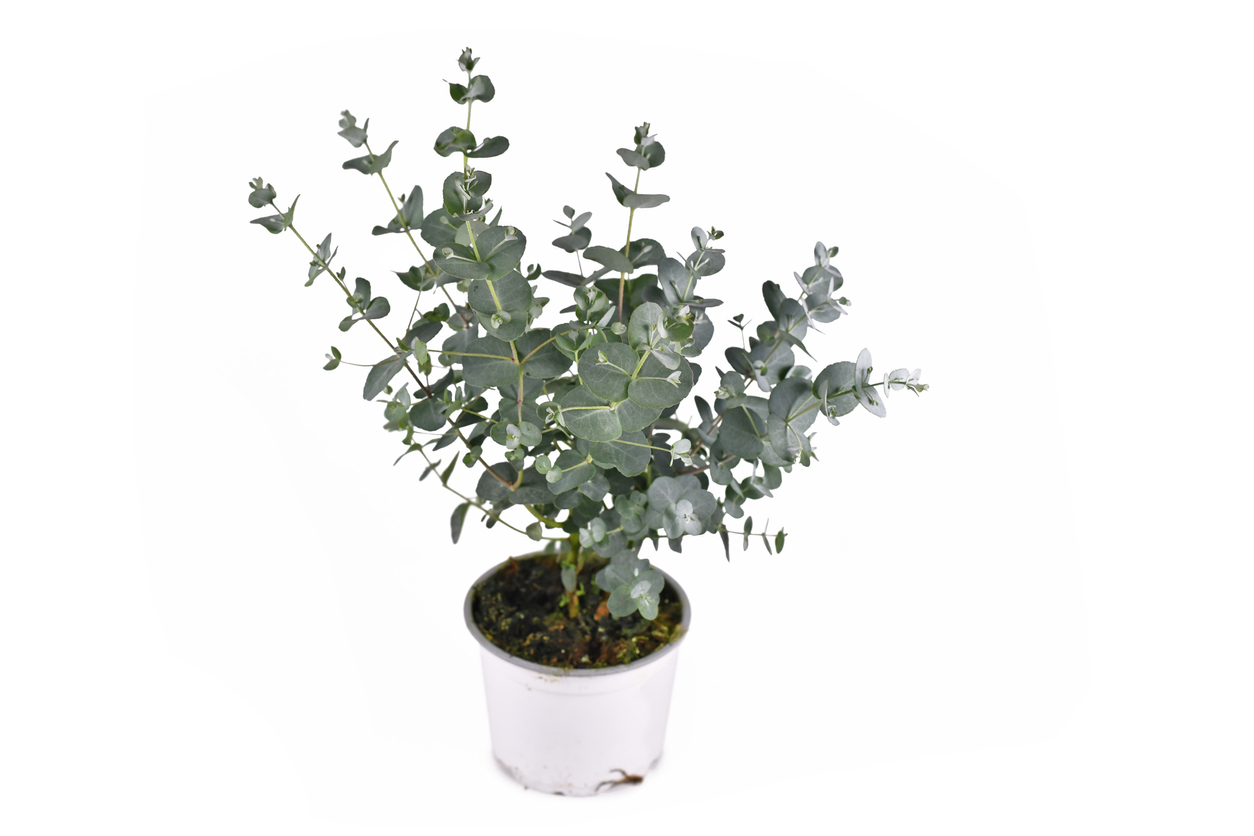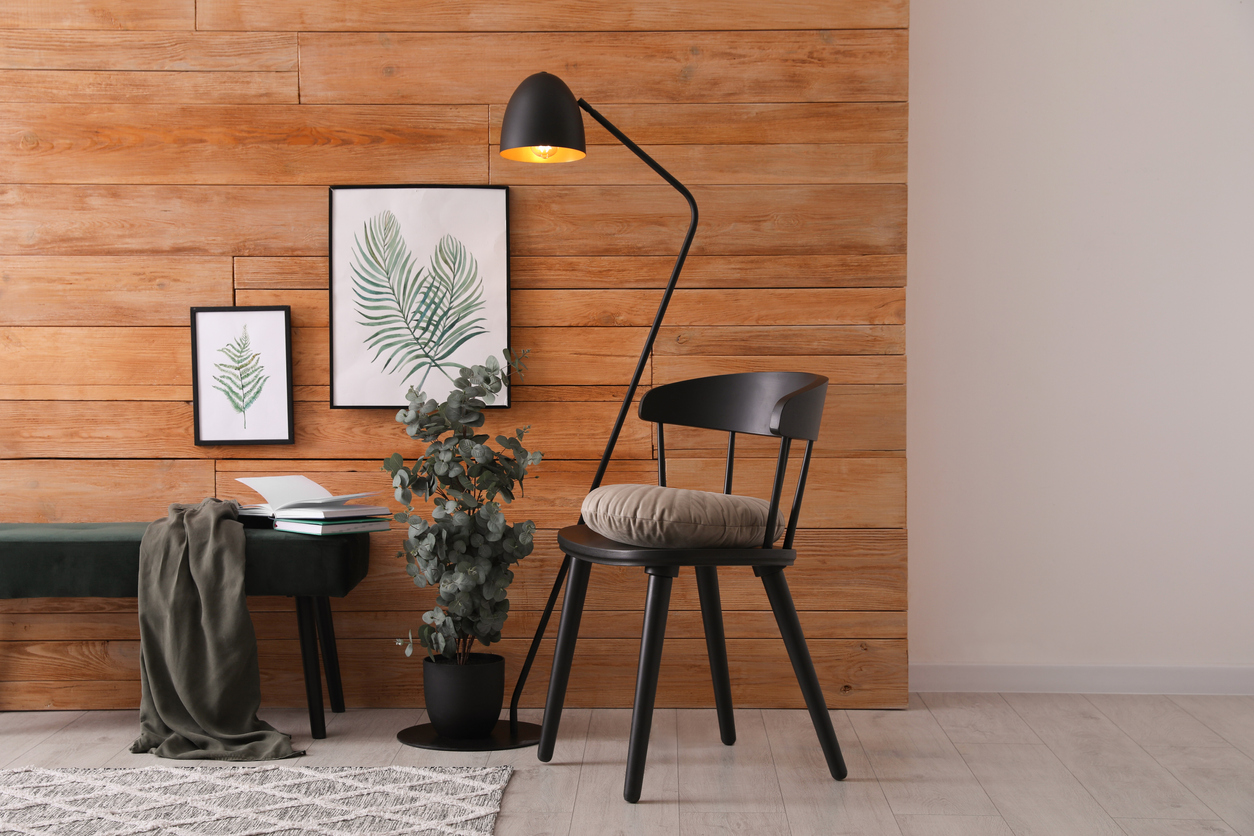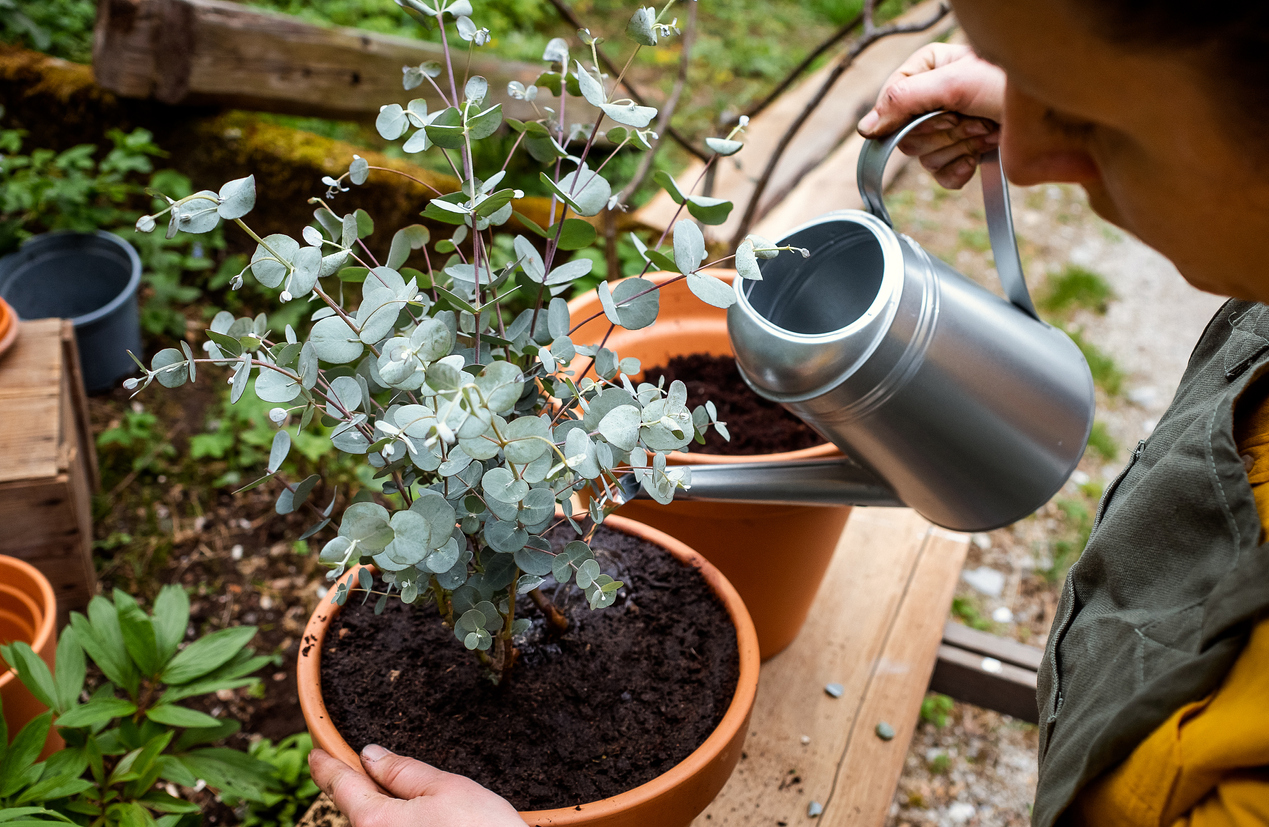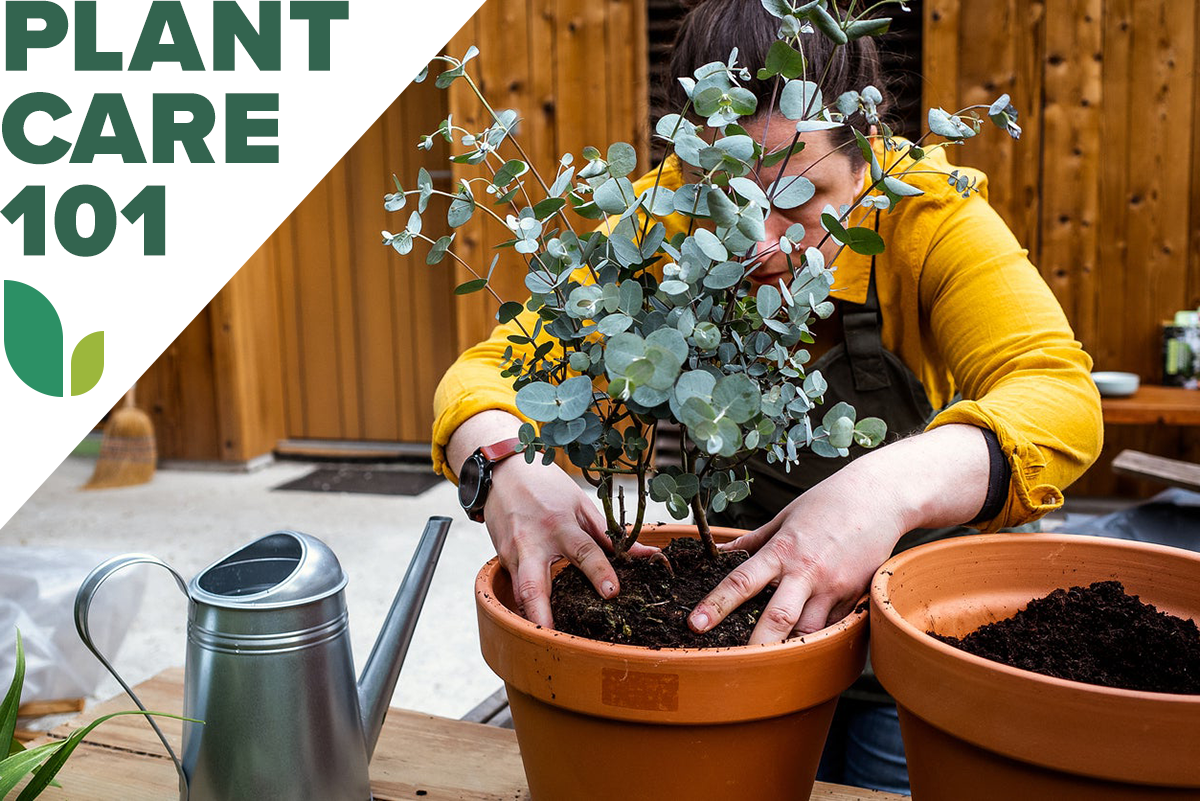We may earn revenue from the products available on this page and participate in affiliate programs. Learn More ›
If you’ve ever dabbled in aromatherapy—or if you’re a koala bear—you’re probably familiar with the fragrant leaves of the eucalyptus plant. This Australian native plant was once grown for firewood and timber, as well as for medicinal purposes. It’s also the primary food source for koalas, and the tree is more popular than ever thanks to the ubiquity of eucalyptus oil.
Today, eucalyptus plants still have medicinal uses. The oil from eucalyptus trees is added to cough and cold medicines to relieve congestion, as well as to creams and ointments to treat muscle and joint pain and to fight inflammation. The aromatic plant can even ease some asthma and sinusitis symptoms, all of which make it a great option for growing at home.
Eucalyptus Plant Care at a Glance
Common Name: Eucalyptus
Scientific Name: Eucalyptus spp.
Soil: Well-draining, acidic to neutral pH
Light: Full sun
Water: Regular watering when top third of soil is dry
Food: Low-nitrogen liquid fertilizer every few weeks in the spring
Temperature and Humidity: 65 to 71 degrees Fahrenheit; average humidity
Propagation: Seeds, grafting, or cuttings
Safety: Toxic to humans and pets when ingested

Eucalyptus Plant Characteristics
Where does eucalyptus grow? Most eucalyptus species are native to Australia (a few occur naturally elsewhere in Oceania) but has been introduced to places around the world. Hardy in USDA zones 8 through 11, eucalyptuses become tall trees when outdoors, growing up to 10 feet per year and featuring distinctive peeling bark. They can live up to 250 years in the wild and are considered evergreen.
It’s possible to grow a eucalyptus indoors, given enough light. They like to summer outdoors, where their fragrant half-moon-shaped leaves rustle in the breeze. Because they grow rapidly, pruning can help contain them…at least for a while.
Eucalyptus leaves are typically dark green, thick, glossy, and almost leathery. They grow horizontally on a straight trunk. Under proper conditions, the plant will produce white flowers and fruit, also called gum nut, a hard woody capsule. The trunk emits a sticky sap when injured. Perhaps most noticeable eucalyptus trait is the distinct camphoraceous smell its leaves produce.
Types of Eucalyptus
Growing eucalyptus indoors is possible, particularly with the right variety. There are more than 700 types of eucalyptus, some of which are more suited to container-growing indoors.
- Eucalyptus gunnii, called cedar gum or cider gum, is among the more cold-hardy eucalyptus types and features rounded silver-blue leaves and red stems that are popular dried for use in floral arrangements.
- Eucalyptus cinerea, or Argyle apple, has highly fragrant round- or egg-shaped silvery leaves that grow in pairs. The leaves are frequently dried and sold in bunches.
- Eucalyptus neglecta ‘Big O’ is a cold-hardy type gaining popularity in the United States. Its young foliage features a blue color with red highlights and characteristic eucalyptus fragrance.
Selecting Soil for Eucalyptus Plants
If you’re trying to figure out how to grow eucalyptus indoors, start with the right soil. While eucalyptuses can tolerate most types of soil, they prefer a high-quality, well-draining potting mix. Soil should be rich, loose, and fertile, with a neutral to slightly acidic pH. If the houseplant potting soil is too dense, adding perlite can boost drainage. In fact, a potting mix with two parts compost to one part perlite is recommended.
Make a soil mixture by combining one part houseplant soil, one part peat moss, and one part perlite or coarse horticultural sand. This blend provides nutrients without retaining too much moisture.

The Right Light
These indoor trees like a lot of light. Give them a minimum of 6 hours of direct sunlight or at least bright light every day, and 8 to 10 hours of sun is even better. Placing a potted eucalyptus plant near a south- or west-facing window generally should provide sufficient midday and evening sun for it to thrive.
In moderate climates, potted eucalyptus plants can be placed outside during summer. Choose a sunny but protected location and remember to transition it gradually so it doesn’t get sunburned, and be sure to bring it back inside before temperatures drop near freezing in the fall.
Watering Eucalyptus Plants
Although eucalyptus plants are partially drought-tolerant when grown outdoors, potted indoor plants should be watered regularly to prevent droop and leaf drop. Watering once a week is a good rule of thumb, but be sure to check if the plant needs watering. Overwatering results in yellowing leaves, brown mushy spots on the stems, and root rot.
To judge when they need more water, check the top one-third of the potting mix. If it’s dry, it’s time to water, but only water when that top layer of soil is dry. Drench the soil thoroughly until water drains out the bottom of the container.
RELATED: This Money Tree Care Routine is Ideal for Newbie Plant Parents
Fertilizing Eucalyptus Plants
During the growing season, the fast-growing eucalyptus can benefit from the extra nutrients provided by fertilizing. Use a liquid houseplant fertilizer (preferable over an all-purpose fertilizer) every few weeks in the spring. It should be high in potassium and low in nitrogen and phosphorus.
Do not fertilize eucalyptus during the fall and winter. If a crusty coating appears on the soil, lower leaves begin to yellow, brown spots appear, or the tree drops leaves, it could be a sign the eucalyptus has been overfertilized. To save the plant, remove dead and dying foliage along with any visible fertilizer. Flush the soil and let it drain thoroughly. Then, withhold fertilizer for about a month.

Setting the Temperature and Humidity
Grown in Australia’s plains and savannas, eucalyptus grows best in sunny, dry climates. Even inside of a house, eucalyptus plants need warm temperatures, but they don’t want to be too hot. The ideal temperature range is between 65 and 71 degrees Fahrenheit for best growth. These plants don’t tolerate cold weather and cannot survive sustained temperatures below 50 degrees.
Coming from an arid climate, eucalyptus plants do well with moderate or average humidity, making them good candidates for indoor living. A humidity level around 40 percent is typically enough to keep them happy. There should be no need to mist the leaves of a eucalyptus like more humidity-loving houseplants require.
Propagating Eucalyptus Plants
There are a few approaches when it comes to how to propagate eucalyptus. Plants can be grown from seeds, grafts, or by cuttings. Propagation by cuttings is often the easiest, most inexpensive method.
The best time to take a cutting from a juvenile eucalyptus plant (between 2 and 12 months old) is spring or late summer. It’s harder to root mature stems. Each cutting should be 3 to 5 inches long, with four to eight leaves. After making a clean cut below a leaf node, set the cutting in a bucket of water until it’s planted.
Strip off the bottom leaves, dip the stem in rooting hormone, and plant the cutting in a pot with well-draining potting soil. When taking more than one cutting, space them 3 inches apart. Cover the container with plastic and place it in a warm, bright space that is not in direct sunlight. Monitor the pot’s moisture level. In about 30 days, roots should appear.
Safety Considerations
Eucalyptus is toxic to people and most pets if consumed orally. Additionally, eucalyptus has been found to interact with some medications, particularly those processed by the liver.
However, clinical studies indicate that the eucalyptus leaves and oil have antifungal and antiseptic properties when applied topically to human skin. Eucalyptus oil is a featured ingredient in many commercial products, and is safe for human use in those forms. Nevertheless, pregnant and breastfeeding women should not use eucalyptus products in this way.
As with most essential oils, eucalyptus oil should never be applied to pets. Pets can experience vomiting, diarrhea, confusion, seizures, and other symptoms if they ingest eucalyptus.

Potential Pests and Diseases
With proper eucalyptus plant care and conditions, the tree can fare well indoors or outdoors. However, it is susceptible to a number of diseases, some of them very common, including: crown and root rot, powdery mildew, leaf spot, wood decay, heart rot, stem canker, and myrtle rust. Botryosphaeria canker is one of the most common diseases. It causes stem cankers, production of gum, and stunted growth. Many of these are types of fungi.
Eucalyptus can also suffer from pest infestations. Eucalyptus leaf beetles (tortoise beetles) have made their way from Australia to California. Other sap-sucking insects, such as the winter bronzing bug, can damage the plants. Another common pest is the red gum lerp psyllid, which secretes a sticky “honeydew” that results in leaf drop. That, in turn, attracts the eucalyptus long-horned borer, which burrows into the plant to lay eggs.
RELATED: 15 Trees and Shrubs That Thrive in Containers
FAQs About Eucalyptus Plant Care
Find quick answers to common questions about eucalyptus plants here.
Q. Is eucalyptus a good indoor plant?
Eucalyptus is an attractive and fragrant plant that can do well inside because it doesn’t require high humidity, although it does like a lot of light.
Q. Why is my eucalyptus plant dying?
It could be too cold, overwatered or underwatered, overfertilized, or diseased. Keeping track of changes to leaf color, lead drop, or signs of mildew or fungus can help prevent these problems.
Q. How often do you water eucalyptus?
Water when the top one-third of the soil is dry—typically, once a week.
Q. How do you encourage eucalyptus growth?
To encourage growth, give it good soil, lots of light, not too much water, and prune it for shape and size.
Q. Are eucalyptus leaves poisonous?
Eucalyptus leaves are toxic if ingested, but are not poisonous to the touch.
Q. Can eucalyptus grow in pots?
Eucalyptus does very well in pots as long as it gets sufficient light and water, and has rich, well-draining soil.
Looking for more fragrant plants? Check out our guides on growing lavender, orchids, and lemon trees.


